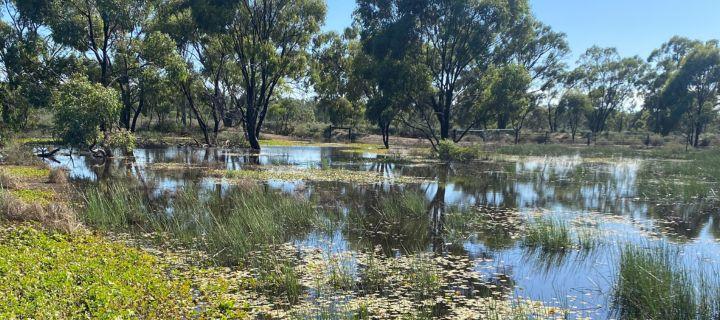Gordon and Eirlys Farrant may come from two different sides of the world, but together they found their home on the Wakool River in the western Riverina district.

Gordon grew up on the family farm west of Deniliquin in NSW, and while traveling in Britain in the 1970s, he met local biology teacher, Eirlys. Their shared interest in wildlife drew them together and they are now the proud owners of Fairview, a 1018 hectare property outside Barham.
They moved to the property in 2000 and entered into a funded conservation agreement in 2019 to protect more than 5km of Wakool River frontage and 283 hectares of associated riverine and floodplain habitats.
Like many of our conservation agreement-holders, they have seen the natural habitats on their land subjected to climatic extremes.
The 2018-2019 drought was followed by three years of higher-than-average rain, resulting in flood levels reaching record-breaking 1955-56 flood heights.
In 2022, they received 701mm of rain: around 300mm above average for the area.
According to Gordon most of their conservation area was flooded from September 2022 to February 2023.
“We are keen bird watchers so we understand the positive outcomes that can come from flooding in this area,” Gordon said.
“There was an increase in wildlife, including species such as the freckled duck, musk duck and several hatchlings of broad-shelled turtles. Also, the healthy growth of the native lignum became great habitat for other threatened birds.”
Gordon said, in total, the couple recorded 74 species of birds in 12 months. The numbers, he said, were much higher than normal and attributable to the rain and a strong breeding year.
”We were excited to observe two species, the diamond firetail finch and southern whiteface, which are both listed as vulnerable in NSW,” he said.
It’s not just the birds that are thriving. Gordon and Eirlys have also recorded an increase in the number of spotted marsh frogs and barking marsh frogs, plus two ground-dwelling species, the plains and eastern-sign bearing froglets.
With the help of senior landholder support officer Nigel Jones, they are working to manage the downside of years of water inundation, introduced weeds and feral pests.
“Obviously when conditions are good it’s not just the native species you want that thrive,“ Nigel said.

"Our conservation management plans help to support landholders to undertake actions to stay on top of weeds and feral pests that take advantage of the habitat conditions post flooding," he said.
"The conservation agreement at Fairview is in-perpetuity so hopefully gives committed landholders like Gordon and Eirlys a great peace of mind that their sanctuary will be well looked after for many generations to come".